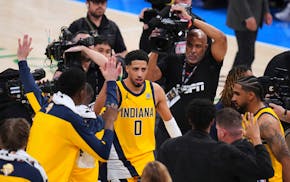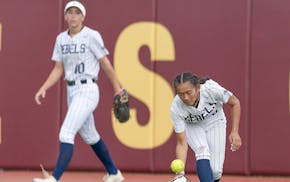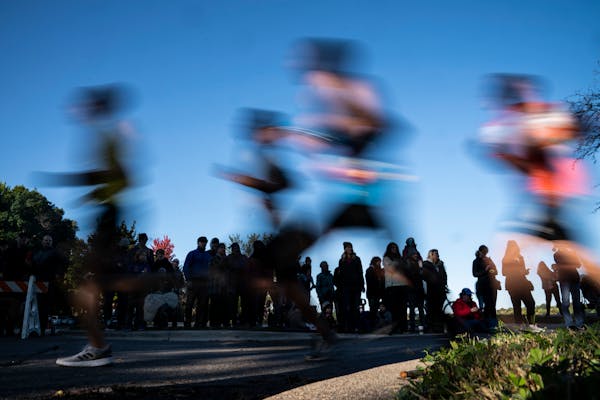After the final runner moves down John Ireland Boulevard in St. Paul toward Mile 26.2 on Sunday, it'll mark the finish line, too, for a longtime organizer of the Twin Cities Marathon.
Virginia Brophy Achman is the executive director of Twin Cities in Motion (TCM), which puts on the signature event and related activities every first weekend in October. Sunday will mark her 20th marathon and 18th as director.
Mary Anderson was president of the volunteer-driven Twin Cities Marathon board in 2000 when Brophy Achman was hired, along with Dan Finanger and Jackie Liu.
Anderson recalled a jolt of new energy and positivity from the three that lifted the then-struggling marathon.
"They created a much better atmosphere for the marathon at the time and brought a lot of new blood," said Anderson, who today organizes hundreds of races across the Midwest through her business, Anderson Race Management. Still, she has volunteered at the marathon for 32 years.
Brophy Achman's hiring also added a woman's voice to a high-profile race operations role in a male-dominated scene, Anderson said. "It helped a lot."
Mike Cofrin, organizer of Minnesota Running Series, said Brophy Achman's high standards for races will be one of her legacies.
"She has been a source of stability and vision for this marketplace," he added.
Brophy Achman still carries a charge all these years later, inspired by new generations of runners and the constants of the marathon experience for runners, volunteers and spectators.
"I am so grateful, and it's an honor," she said. "I never tire of the stories. No matter how much has changed, what hasn't changed is the anticipation and the nerves and the excitement at the start line and the elation and the tears and the frustration at the finish line. And that is never going to change."
In an interview, Brophy Achman talked about this year's milestone (it's the marathon's 40th year), the state of running post-pandemic, and the challenge of turning runners into road racers. As for what's next for her, she is taking time "to explore a lot of things." What follows has been edited for length and clarity.
What is top of mind ahead of the 40th marathon?
I am so excited to be celebrating 40 years. When you think about what the last two years have been like for all of us, we have this opportunity to celebrate. How our runners return, how our volunteers return, how our corporate partners come back stronger than ever — we have so much to be thankful for. It is exceptionally exciting to be able to come back as strong as we are on the other side of the pandemic.
What are the signs that runners are coming back strong?
When I speak to my peers across the country, we are doing better than most. New York, Chicago and Boston are the anomaly. They are the exception. They are different. They are 100% back to their numbers for their marquee event, the marathon. The rest of the industry is all slightly down. In the first quarter, we were down 20% from 2019 and everyone was down more than that. By the time we got to Women Run The Cities [event], we were back to our normal numbers. This fall, the number of registrants is the same as 2019, it just looks different. There are more in the marathon and less in the 10-mile, but the cumulative total is close. We are doing well on Saturday [events], too. It varies all over the country in terms of what kind of return they are seeing.
What changes in running stand out coming out of COVID?
We are really good at acquiring new runners, so our new-runner numbers are high. That didn't change. What's changed is when [a runner is] willing to make a commitment. There are people still willing to set their goals and set their schedule. It is a solid number. When you look at the shorter distances, the decision comes much later, closer to the event.
Running remains the most popular activity nationally, but fewer young people are active.
What we have to do is meet people where they are. It is more than running. It is experiential, and that is the shift that our industry has to make and that TCM is making. We offer surveys. We ask our runners what they want. We look at national Running USA surveys. There is great competition for discretionary dollars. You have so many choices. Even if you picked up running during the pandemic, that is not going to translate to 'Now, I am going to sign up for a race.' That's different. Running increased, but it is not translating down to the races. We are listening to what our customer wants. How do we provide a community? We are hoping that you crave that running community, that you come back to us and be part of something greater than yourself. You get to have your dreams, goals and aspirations, but you get to share them with others.
What have you done to make that connection?
We try to offer different themes — each race has its own personality and character. And the distance matters. One thing we have done is get very social. A beer garden makes people hang out and share their experiences. Just be. When we have a beautiful day in the spring and are anxious to get outside, that is a gift. They want to have a beer and hang out.
The most powerful tool is referrals. Encouraging people to invite their friends. We have our ambassador program to help be an extension of us, to say "Come and join us." At the end of the day, what are your friends doing and where are they? And if they are running with us, we want you to come along, too.
What would make the marathon weekend better?
Getting back to experience … we are introducing live art. We are asking the art community to come out and be a part of our weekend. Part of that hope is to reach a new community. I have run a lot of marathons that are very quiet and very lonely. We are trying to be mindful about how to integrate more of the community and more of that support, which in turn is a better running experience because you have more people out there cheering or entertaining or whatever the activation may be. For our 40th, we have over 40 different activations on the course.
All kids 18 and younger run free. I think that is one of the most impactful things we have done. That has been transformational. Our kids numbers are going up, and hopefully, their parents are coming. Now it is more affordable. If money is a barrier, we are trying to eliminate that barrier. It has been really well-received. We have our school program, so the teachers are like, this is so easy. Now they just sign up the kids and they don't have to worry about it. It's free. For schools that participate, we are offering free transportation to make it easier to bring a whole class or grade or school running program.
Running can ebb and flow with your whole life. If we can instill running and movement in children, it is something that will stick with them.
What about your experience at TCM?
We have worked hard to keep our crown jewel relevant and important, and front and center. I never take for granted that we get to do this. I have so many peers in other cities who can't do it. We are so fortunate to have Minneapolis and St. Paul. Both of those cities support it, care about it, value it. They continue to help us make this work.

Podcast: How the Pacers taught the Thunder (and the Wolves) a playoff lesson

Softball state tournament: Live updates from championship games at Jane Sage Cowles Stadium
Yuen: How success has pushed Minnesotans off sidelines in trans athlete debate
David Festa's return to Twins goes south in a hurry

